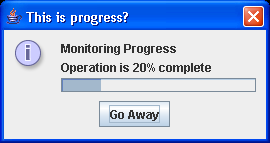A demonstration of the ProgressMonitor toolbar

/*
Java Swing, 2nd Edition
By Marc Loy, Robert Eckstein, Dave Wood, James Elliott, Brian Cole
ISBN: 0-596-00408-7
Publisher: O'Reilly
*/
// ProgressMonitorExample.java
// A demonstration of the ProgressMonitor toolbar. A timer is used to induce
// progress. This example also shows how to use the UIManager properties
// associated with progress monitors.
//
import java.awt.event.ActionEvent;
import java.awt.event.ActionListener;
import javax.swing.JFrame;
import javax.swing.ProgressMonitor;
import javax.swing.SwingUtilities;
import javax.swing.Timer;
import javax.swing.UIManager;
public class ProgressMonitorExample extends JFrame implements ActionListener {
static ProgressMonitor pbar;
static int counter = 0;
public ProgressMonitorExample() {
super("Progress Monitor Demo");
setSize(250, 100);
setDefaultCloseOperation(JFrame.EXIT_ON_CLOSE);
pbar = new ProgressMonitor(null, "Monitoring Progress",
"Initializing . . .", 0, 100);
// Fire a timer every once in a while to update the progress.
Timer timer = new Timer(500, this);
timer.start();
setVisible(true);
}
public static void main(String args[]) {
UIManager.put("ProgressMonitor.progressText", "This is progress?");
UIManager.put("OptionPane.cancelButtonText", "Go Away");
new ProgressMonitorExample();
}
public void actionPerformed(ActionEvent e) {
// Invoked by the timer every half second. Simply place
// the progress monitor update on the event queue.
SwingUtilities.invokeLater(new Update());
}
class Update implements Runnable {
public void run() {
if (pbar.isCanceled()) {
pbar.close();
System.exit(1);
}
pbar.setProgress(counter);
pbar.setNote("Operation is " + counter + "% complete");
counter += 2;
}
}
}
Related examples in the same category